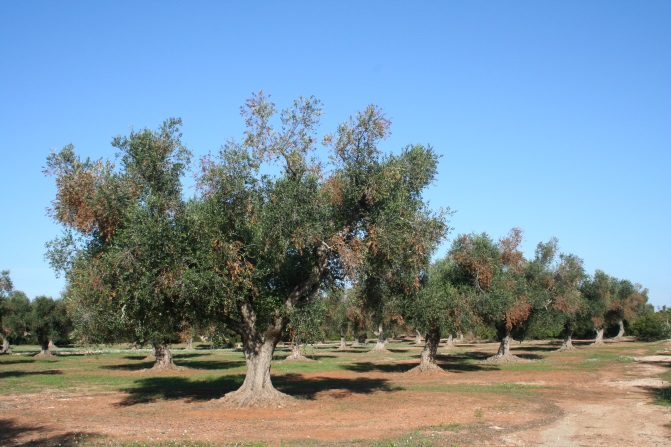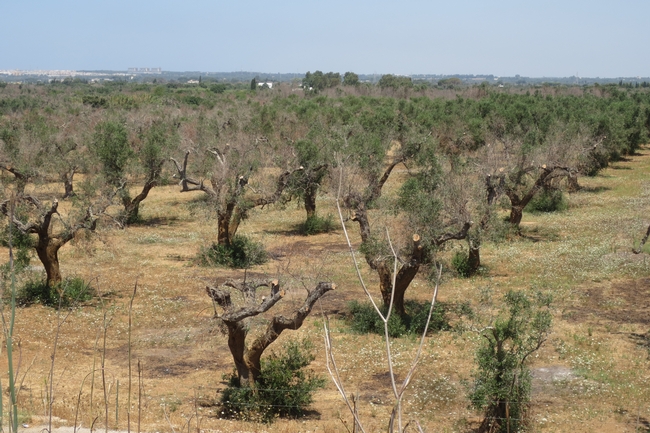
Olive quick decline
| Primefact number | Edition | Published | Author |
|---|---|---|---|
| 1521 | First | Feb 2017 | Plant Biosecurity and Product Integrity |


![Figure 3 Adult meadow spittle bug (Philaenus spumarius) [5-7 mm in length] (Image: Cheryl Moorehead, Bugwood.org) Adult meadow spittle bug, mostly black in colour with some white markings on the wings and yellow eyes.](https://www.dpi.nsw.gov.au/__data/assets/image/0005/1150619/OliveQuickDecline3.jpg)
![Figure 4 Adult glassy winged sharpshooter (Homalodisca vitripennis) [12-14 mm in length] (Image: Roy Niswanger, Texas) An adult glassy winged sharpshooter on a leaf showing black/brown head, clear wings with distinct red patterning and white colour of lower abdomen](https://www.dpi.nsw.gov.au/__data/assets/image/0017/1150622/OliveQuickDecline4.jpg)
Olive quick decline syndrome (Xylella fastidiosa) is not known to occur in Australia. This disease is a serious threat to Australia’s olive industry.
Olive quick decline syndrome (OQDS) is caused by a distinct strain of the bacterium Xylella fastidiosa. The bacterium lives and multiplies in the sap of olive trees, blocking water and nutrient uptake.
Sap feeding insects spread the bacteria between plants. Once a plant is infected there is no treatment other than to remove infected limbs or whole trees to try and prevent spread.
Different strains of Xylella fastidiosa are responsible for a number of diseases in other horticultural crops, including Pierce’s disease of grapevine, citrus variegated chlorosis, leaf scorch of tree nuts, and phony peach disease. No strains of X. fastidiosa are known to be present in Australia.
Notifiable status
Xylella fastidiosa is a notifiable plant disease in NSW.
All notifiable plant pests and diseases must be reported within 1 working day. You can report notifiable plant pests and diseases by one of the following methods:
- Call the Exotic Plant Pest Hotline 1800 084 881
- Email biosecurity@dpi.nsw.gov.au with a clear photo and your contact details
- Complete an online form
A full list of notifiable plant pests and diseases can be found in Schedule 2 of the NSW Biosecurity Act 2015.
Description
The first sign of OQDS is scattered leaf scorching and twig death throughout the upper part of the canopy (Figure 1).
Leaf scorching begins as a browning at the tip of the leaf, spreading towards the base until the whole leaf is covered. Dead leaves remain attached to the branches until dislodged by rain.
Browning and branch death spreads throughout the canopy giving the tree a burned appearance. These leaf scorch and dieback symptoms can be easily confused with several other olive tree diseases and environmental disorders. Laboratory tests are necessary to confirm the actual cause of symptoms.
Damage
The presence of X. fastidiosa in the plant sap restricts flow of water and nutrients in the tree.
There is no known treatment for OQDS once trees become infected. Pruning of infected trees produces new growth which succumbs to leaf burn after a short while.
Eventually trees develop a skeletal look with an abundance of suckers produced from the base of the trunk (Figure 2).
Trees infected with OQDS eventually become unproductive but continue to survive and produce suckers as long as the roots are viable.
Spread
Xylella fastidiosa bacteria are carried in the sap of host plants and can be spread between plants by grafting, pruning or sap feeding insect vectors.
In Italy, where OQDS is prevalent, the main vector appears to be the meadow spittle bug (Figure 3).
The most efficient known vector of X. fastidiosa strains elsewhere is the glassy-winged sharpshooter (Figure 4).
Neither the meadow spittle bug nor glassy-winged sharpshooter is currently found in Australia. It is possible that related Australian native insect species could be vectors of X. fastidiosa in Australia.
Introduction of the disease to Australia could occur through human assisted movement of infected plant material or with insect vectors. The disease is not spread by seed.
Distribution
Xylella fastidiosa is native to the Americas and has spread to Europe where there have been recent detections in Italy and France. OQDS was identified in Italy in 2013 and is the first case of X. fastidiosa causing major damage to olives.
Xylella fastidiosa is also present in the Caribbean, Taiwan, Iran, Turkey, Lebanon and Kosovo. Presence in India and Morocco is unconfirmed.
Actions to minimise risk
Put in place biosecurity best practice actions to prevent entry, establishment and spread of pests and diseases:
- practice “Come clean, Go clean”
- ensure all staff and visitors are instructed in and adhere to your business management hygiene requirements
- monitor your olive grove regularly
- monitor and control weeds that can harbour both the disease and its vectors
- source plant material of a known high health status from reputable suppliers
- keep records

